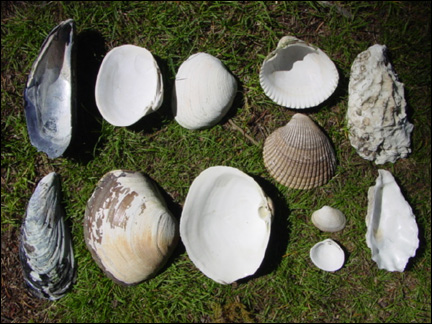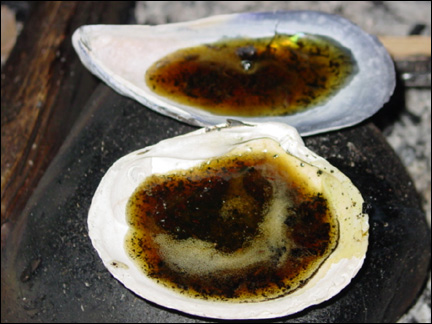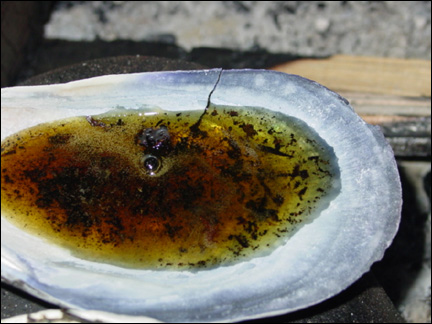
Melting pitch can be a tricky business. A lot can happen between scraping pitch from a tree and finishing a batch of pitch sticks. After heat has greatly increased its viscosity, this substance seems to instantly drip onto, run over, and adhere to materials that you least want to introduce the stickiest of natural adhesives. Getting the stuff on your skin (especially hairy skin!) is a veritable scourge, remedied by alternately rubbing wads of bedstraw (Galium spp.) and clumps of sandy-dirt onto the affected area.
Around here, pitch isn’t found in abundance. In fact, I treasure every single glistening drop I see. I’m careful to not waste it, which inspires me to find small, re-usable, energy-efficient (my energy) containers that serve in collection and melting. Once you use a container to hold or melt pitch, it becomes forever committed to this purpose.
My area offers no rock to be effectively pecked-and-ground, no clay to pinch a pot from, but is laden with a seemingly endless supply of seashells. Up here on the Olympic Peninsula of Washington, there are areas on the coast where I’ve collected 350 large, unbroken shells in 90 minutes, having covered an area under a quarter-acre. For a person whose lithic technology has barely graduated from the “Oldowan Bashee” tool tradition, great importance is placed upon the use of natural, found items as vessels for the preparation of practical amounts of glue, medicine, tea, and pigment. (A good article by Richard Jamison entitled, “The Use of Pitch,” can be found in the book, The Best of Woodsmoke: A Manual of Primitive Outdoor Skills.)

Shells used in this experiment: mussel, butter clam, gaper clam, Nuttall's cockle, littleneck clam and oyster.
I chose twenty-five shells from each of the larger species that I could find and melted pitch in them. To test for longevity, I chose another five shells from each species and proceeded to melt pitch in each until either the shell failed or pitch was melted five times. Some shells, like oysters and littleneck clams, proved reliable enough to use just once. Butter clams demonstrated the greatest resiliency over the long haul, as did gaper clams to a slightly lesser extent. As a result of my experience, I would not recommend using cockles and mussels. Here are the pros-and-cons for each species that I observed throughout the melting trials.
Butter Clams—4% failure rate
+ large/deep
+ thick
+ the most crack-resistant shell-type tested
- a bit difficult to handle with wooden tongs
Gaper Clams—12% failure rate
+ large/deep
+ fairly crack-resistant
- difficult to handle with wooden tongs
Littleneck Clams—20% failure rate
+ fairly crack-resistant
+ easy to handle with wooden tongs
- usually quite small
Pacific Oysters—56% failure rate
- irregularly shaped-shells don’t often sit upright
- difficult to find one with a useful concavity
- difficult to handle with wooden tongs
- becomes very fragile after having been heated
Nuttall’s Cockles—76% failure rate
Blue Mussels—92% failure rate
+ both shell types are large/deep
+ plentiful
+ very easy to handle with wooden tongs
- readily cracks

Melting pitch in butter clam shell (foreground) and mussel shell (background).

Failed mussel shell.
I give a heartfelt thanks to the Makah Tribe for granting me special permission to collect shells on their sparkling, productive shores.
Visit Storm's website at www.stoneageskills.com.
Storm (1969 - 2008)
Storm immersed himself into the wellspring of adventure and the experience of the Stone Age. Thank you, Storm, for sharing your heartfelt enthusiasm of the wilderness and skills of the past through your engaging articles. You will be sorely missed.
We hope the information on the PrimitiveWays website is both instructional and enjoyable. Understand that no warranty or guarantee is included. We expect adults to act responsibly and children to be supervised by a responsible adult. If you use the information on this site to create your own projects or if you try techniques described on PrimitiveWays, behave in accordance with applicable laws, and think about the sustainability of natural resources. Using tools or techniques described on PrimitiveWays can be dangerous with exposure to heavy, sharp or pointed objects, fire, stone tools and hazards present in outdoor settings. Without proper care and caution, or if done incorrectly, there is a risk of property damage, personal injury or even death. So, be advised: Anyone using any information provided on the PrimitiveWays website assumes responsibility for using proper care and caution to protect property, the life, health and safety of himself or herself and all others. He or she expressly assumes all risk of harm or damage to all persons or property proximately caused by the use of this information.
© PrimitiveWays 2013